|
|
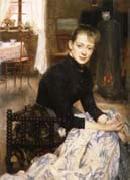 |
Richard Bergh
|
|
1858?C1919,Painter, writer and museum director, son of Edvard Bergh. He studied in Stockholm, first at the art school of Edvard Pers?us (1841-90) and from 1878 to 1881 at the Konstakademi, where he met Nils Kreuger and Karl Nordstrem. His early work consists mainly of academically treated scenes from Swedish history and legend. In 1881 he left for France, studying in Paris with Jean-Paul Laurens and at the Academie Colarossi (1881-4); he made his debut at the Salon of 1883. In 1885, with Ernst Josephson and other members of the Scandinavian artists' colonies in Paris and Grez-sur-Loing, he became one of the main promoters of the Opponenterna, a movement of protest against the conservative attitudes of the Konstakademi; the following year this group formed the Konstnersferbund (Artists' Union), of which Bergh was a leading member throughout his life. |
|
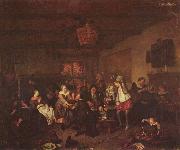 |
Richard Brakenburgh
|
|
(1650, Haarlem - 1702, Haarlem), was a Dutch Golden Age painter.
According to Houbraken he was a light-hearted poet from Haarlem. He was the pupil of Hendrik Mommers who went on to paint clever genre scenes in the manner of Adriaen van Ostade. Though some said he was the pupil of Bernard Schendel, they were the same age and painted in similar styles. He was successful enough at his art that his Frisian widow was able to purchase an annuity after his death in Friesland.
According to the RKD he is registered in Leeuwarden during the years 1670-1687.He is known for both Italianate landscapes and portraits. He painted similar subjects to those of Schendel, representing merry-makings and drunken assemblies. His pictures are ingeniously composed, and well coloured, something in the manner of Adriaan van Ostade, though greatly inferior. They are painted with facility, although they have the appearance of being very highly finished; and he perfectly understood the management of chiaroscuro. His greatest defect is his incorrect drawing of the figure, which he appears not to have studied from nature. The Vienna Gallery has two 'Peasant Scenes' by him, said to have been painted in 1690; the Berlin Museum one, and the Amsterdam Gallery one. In the Brussels Gallery is a 'Children's Feast,' signed and dated 1698; and the Rotterdam Museum has a 'Doctor's Visit,' signed and dated 1696. In Windsor Castle are two good 'Artists' Studios ' by him. He also sometimes practised the art of engraving.
He was the teacher of Wigerus Vitringa, Abraham Pardanus, and Gillis de Winter. He was followed by Jan Steen and Bernardus van Schijndel. He died at Haarlem in December 1702 and was buried in January 1703.
|
|
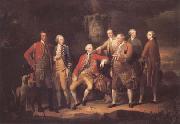 |
Richard Brompton
|
|
1734-1783
English painter. He trained in London with Benjamin Wilson before going to Rome in 1757, where he studied with Anton Raphael Mengs. In Rome he met Charles Compton, 7th Earl of Northampton, who paid him an allowance and in Venice in 1763 introduced him to Edward Augustus, Duke of York. The Duke commissioned a conversation piece of himself and his travelling companions (version, 1764; London, Kew Pal., Royal Col.). The figures are awkwardly posed, but the polished elegance of each shows the influence of Mengs. In 1765 Brompton returned to London with Nathaniel Dance and established a good practice with small-scale works in the manner of Johann Zoffany, such as William Pitt, 1st Earl of Chatham (1772; Chevening, Kent), which exists in several versions. He also produced portraits on a larger scale, including the enormous Henry Dawkins with his Family (1773; Over Norton Hall, Oxon). |
|
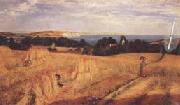 |
Richard Burchett
|
|
British painter and art teacher , (1815-1875)
was a British artist and educator on the fringes of the Pre-Raphaelite movement, who was for over twenty years the Headmaster of what later became the Royal College of Art. He was later described as "a prominent figure in the art-schools, a well instructed painter, and a teacher exceptionally equipped with all the learning of his craft" by his ex-pupil, the poet Austin Dobson. Burchett's pupils included the extremely varied talents of Kate Greenaway, Christopher Dresser, Elizabeth Thompson (Lady Butler), Sir George Clausen, Sir Luke Fildes, Gertrude Jekyll, Hubert von Herkomer, William Harbutt and Helen Allingham. Princess Louise, Duchess of Argyll, Queen Victoria's daughter, and a talented artist, was also a student.As an artist he achieved some reputation for large history paintings, but View across Sandown Bay, Isle of Wight is seen by modern art historians as his best work. |
|
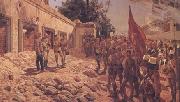 |
Richard Caton Woodville
|
|
1856 - 1927
was an English artist and illustrator, who is best known for being one of the most prolific and effective painters of battle scenes in the late nineteenth, and early twentieth centuries. The son of American Richard Caton Woodville (The First), who was also a talented artist, Woodville studied at the Dusseldorf School under the great Prussian military artist Wilhelm Camphausen, and then Eduard von Gebhardt, before briefly studying in Russia and then Paris under Gerome. Woodville spent most of his career working for the Illustrated London News where he quickly developed a reputation as a talented reporter and writer, but was also published in Cornhill Magazine, Strand Magazine, and The Tatler. Richard Caton Woodville first experienced battle first-hand when he was sent by the Illustrated London News to report upon the Russo-Turkish War (1877 C 1878), and then again in the 1882 Anglo-Egyptian War where he made numerous sketches, and also obtained photographs of the trenches at Tel-e-Kebir for his friend and co-artist Alphonse-Marie-Adolphe de Neuville whom had been commissioned to paint a scene of the battle. In 1879 Woodville's Before Leuthen, Dec 3rd, 1757 was exhibited in the Royal Academy. It proved popular, and afterwards he began to regularly be exhibited in Burlington House, where 21 of his battle paintings were eventually shown. His most popular works there were ones that dealt with contemporary wars, such as the Second Anglo-Afghan War, Candahar [sic], and Maiwand, Saving the Guns (Walker Art Gallery), the Zulu War, and the First Boer War. His works from Egypt were exhibited at the Fine Art Society in 1883, where his painting The Moonlight Charge at Kassassin proved very popular. The following year he exhibited by Royal Command another painting he had done of the war in Egypt, entitled The Guards at Tel-e-Kebir (Royal Collection). He continued to paint scenes of battle, and few battles or wars that Great Britain fought during his life were not touched upon by him, including the Second Boer War, and World War I. Despite his precocious talent for capturing the dramatic moments of contemporary battles, Woodville also enjoyed recreating historical scenes in both oil, and watercolour. The Illustrated London News commissioned him to complete a commemorative special series recreating the most famous British Battles of history. He depicted The Charge of the Light Brigade (Royal Collection, Madrid) and The Charge of the 21st Lancers at Omdurman (Walker Art Gallery), Battle of Blenheim, Battle of Badajos and several Battle of Waterloo pictures. During World War I, Woodville was compelled to return to the depiction of current events, and three of his Great War works were displayed in the Royal Academy. |
|
|
|
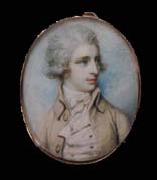 |
Richard Cosway
|
|
English Rococo Era Miniaturist, 1742-1821,Painter, draughtsman, dealer and collector. Probably the son of a schoolmaster, he showed a precocious talent for drawing and studied at Shipley's Drawing School in the Strand, where he won several prizes. He attended the Richmond House academy, set up by Charles Lennox, 3rd Duke of Richmond, where he met Giovanni Battista Cipriani. He first exhibited at the Society of Artists in 1760, showing there again between 1767 and 1779. He also showed at the Free Society of Artists between 1761 and 1766. In 1769 he entered the Royal Academy Schools, becoming an ARA in 1770, when he began to exhibit at the Academy, and RA the following year. In 1781 Cosway married the Anglo-Florentine artist Maria Cosway, n?e Hadfield, and they moved in 1784 to Schomberg House, Pall Mall, which became a centre for fashionable London society. In 1786 he made a brief visit to Paris and in 1791 he moved to a larger house in Stratford Place, London. |
|
|
|
 |
Richard Dadd
|
|
1817-1886
was an English painter of the Victorian era, noted for his depictions of fairies and other supernatural subjects, Orientalist scenes, and enigmatic genre scenes, rendered with obsessively minuscule detail. Most of the works for which he is best known were created while he was incarcerated in a psychiatric hospital. Dadd was born at Chatham, Medway in Kent, England, the son of a chemist. His aptitude for drawing was evident at an early age, leading to his admission to the Royal Academy of Arts at the age of 20. With William Powell Frith, Augustus Egg, Henry O'Neil and others, he founded The Clique, of which he was generally considered the leading talent. In July 1842, Sir Thomas Phillips, the former mayor of Newport, chose Dadd to accompany him as his draftsman on an expedition through Europe to Greece, Turkey, Palestine and finally Egypt. In November of that year they spent a gruelling two weeks in Palestine, passing from Jerusalem to Jordan and returning across the Engaddi wilderness. Toward the end of December, while travelling up the Nile by boat, Dadd underwent a dramatic personality change, becoming delusional and increasingly violent, and believing himself to be under the influence of the Egyptian god Osiris. His condition was initially thought to be sunstroke. On his return in the spring of 1843, he was diagnosed to be of unsound mind and was taken by his family to recuperate in the countryside village of Cobham, Kent. In August of that year, having become convinced that his father was the Devil in disguise, Dadd killed him with a knife and fled for France. En route to Paris Dadd attempted to kill another tourist with a razor, but was overpowered and was arrested by the police. Dadd confessed to the killing of his father and was returned to England, where he was committed to the criminal department of Bethlem psychiatric hospital (also known as Bedlam). Here and subsequently at the newly created Broadmoor, Dadd was cared for (and encouraged to continue painting) by the likes of Drs William Wood and Sir W. Charles Hood, in an enlightened manner. Which condition he suffered from is unclear, but it is usually understood to be a form of paranoid schizophrenia.He appears to have been genetically predisposed to mental illness; two of his siblings were similarly afflicted, while a third had "a private attendant" for unknown reasons.In the hospital he was allowed to continue to paint and it was here that many of his masterpieces were created, including his most celebrated painting, The Fairy Feller's Master-Stroke, which he worked on between 1855 and 1864. Also dating from the 1850s are the thirty-three watercolour drawings titled Sketches to Illustrate the Passions, which include Grief or Sorrow, Love, and Jealousy, as well as Agony-Raving Madness and Murder. Like most of his works these are executed on a small scale and feature protagonists whose eyes are fixed in a peculiar, unfocused stare. |
|
|
|
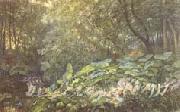 |
Richard Doyle
|
|
1824-1883
English caricaturist, water colorist, and illustrator. He was the son and pupil of John Doyle, a popular caricaturist. His Journal (British Mus.), a book of sketches done at the age 15, shows his extraordinary precocity. He worked on the staff of Punch (1843?C50), |
|
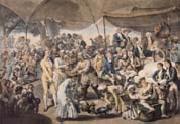 |
Richard Earlom
|
|
English Printmaker, 1743-1822,English printmaker. Taught by Giovanni Battista Cipriani, he worked in mezzotint, etching and occasionally stipple. His mezzotints of flowers and still-lifes, such as Roses for the Temple of Flora (1805) by Robert John Thornton (?1768-1837) or the Fruit Piece (see Wessely, no. 145) after Jan van Huysum, are also found printed in colours or coloured by hand. Earlom's most influential prints were a set of outline etchings combined with mezzotint of the volume, then belonging to the Dukes of Devonshire, of Claude's drawings of his own landscape paintings |
|
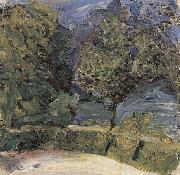 |
Richard Gerstl
|
|
(September 14, 1883 - November 4, 1908) was an Austrian painter and draughtsman known for his expressive psychologically insightful portraits, his lack of critical acclaim during his lifetime, and his affair with the wife of Arnold Schoenberg which led to his suicide.
Richard Gerstl was born in a prosperous civil family, Emil Gerstl, a Jewish merchant, and Maria Pfeiffer, non-Jewish woman. He visited the Viennese Piaristengymnasium (de) (Bundesgymnasium Wien 8 (de), Josefstadt), but he had to leave because of difficulties of discipline.
Early in his life, Gerstl decided to become an artist, much to the dismay of his father. After performing poorly in school and being forced to leave the famed Piaristengymnasium in Vienna as a result of "disciplinary difficulties," his financially stable parents provided him with private tutors. In 1898, at the age of fifteen, Gerstl was accepted the Academy of Fine Arts Vienna where he studied under the notoriously opinionated and difficult Christian Griepenkerl. Gerstl began to reject the style of the Vienna Secession and what he felt was pretentious art. This eventually prompted his vocal professor to proclaim, "The way you paint, I piss in the snow!"
Frustrated with the lack of acceptance of his non-secessionist painting style, Gerstl continued to paint without any formal guidance for two years. For the summers of 1900 and 1901, Gerstl studied under the guidance of Simon Hollesy in Nagybenya. Inspired by the more liberal leanings of Heinrich Lefler (de), Gerstl once again attempted formal education. Unfortunately, his refusal to participate in a procession in honor of Emperor Franz Joseph I of Austria further ostracized him and led to his departure. Gerstl felt that taking part in such an event was "unworthy of an artist." His final exit from Lefler's studio took place in 1908.
In 1904 and 1905, Gerstl shared a studio with his former academy classmate and friend, Viktor Hammer. Although Hammer had assisted in Gerstl's admittance to Lefler's tutelage and their relationship was friendly, it is difficult to determine how close the two men were as Gerstl did not associate with other artists. Regardless of their personal feelings, by 1906, Gerstl had acquired his own studio.
Although Gerstl did not associate with other artists, he did feel drawn to the musically inclined; he himself frequented concerts in Vienna. Around 1907, he began to associate with composers Arnold Schoenberg and Alexander von Zemlinsky, who lived in the same building at the time. Gerstl and Schoenberg developed a mutual admiration based upon their individual talents. Gerstl apparently instructed Schoenberg in art.
|
|
|
|
|
|
|
|
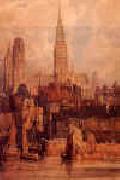 |
Richard Parkes Bonington
|
|
1802-1828
Richard Parkes Bonington Locations
English painter. His father, also called Richard (1768-1835), was a provincial drawing-master and painter, exhibiting at the Royal Academy and the Liverpool Academy between 1797 and 1811. An entrepreneur, he used his experience of the Nottingham lace-manufacturing industry to export machinery illegally to Calais, setting up a business there in late 1817 or early 1818. In Calais the young Richard Parkes Bonington became acquainted with Louis Francia, with whom he consolidated and expanded whatever knowledge of watercolour technique he had brought with him from England. Under Francias direction Bonington left Calais for Paris where, probably not before mid- or late 1818, he met Eugene Delacroix. The latters recollection of Bonington at this time was of a tall adolescent who revealed an astonishing aptitude in his watercolour copies of Flemish landscapes. Once in Paris Bonington embarked on an energetic and successful career, primarily as a watercolourist. In this he was supported by his parents who sometime before 1821 also moved to Paris, providing a business address for him at their lace company premises. |
|
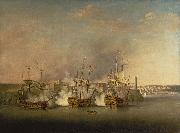 |
Richard Paton
|
|
was a British marine painter.
Paton spent his artistic career in London, where he is said to have been born, although no record of his birthplace or parentage is known. He is said to have grown up in poverty, and he is described as "self-taught". Some critics have discerned an influence of Samuel Scott's works, and also of Charles Brooking. Any such influence is hardly evident.
According to an account by Harry Parker, in "The Mariner's Mirror", March 1912, p 85, while Paton was begging "on Tower Hill, he attracted the attention of Admiral Sir Charles Knowles (died 1777), who happened to be passing that way, and who, taking a fancy to the boy, offered to take him to sea". He was assistant to the shipes painter on Knowles' ship, gaining knowledge in both painting and seamanship. In 1742, he started working at the Excise Office.
His first exhibition was in 1758 on the premises of the London-based Society of Artists, where he continued to exhibit up to 1770. The Royal Academy hosted his works between 1762 and 1780.
Paton's specialities were marine and naval paintings. He painted naval actions of wars ongoing at the time of painting such as the Seven Years War of 1756-1763 and later The American Revolutionary War, as well as earlier events such as the battles of the War of the Quadruple Alliance which took place when he was a baby. The paintings include many dramatic effects such as battles at night, the shooting of cannons and the effect of bombardments. There are, however, also less militant themes such as ships becalmed. His "sublime depiction of the sky" was considered especially noteworthy. Prints of his works, made among others by Pierre-Charles Canot, made them widely known.
|
|
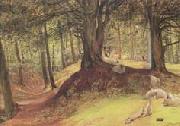 |
Richard Redgrave,RA
|
|
1804-1888
Painter, etcher and administrator, brother of (1) Samuel Redgrave. He trained initially as a clerk and draughtsman in his father's counting-house before becoming a student at the Royal Academy Schools in 1826; he also studied with John Powell. About 1830 he left his father's firm and supported himself as a drawing-master, working in watercolour before attempting to paint in oil. He exhibited at the Royal Academy from 1825 until failing eyesight afflicted him in 1883. He was elected ARA in 1840 and RA in 1851. |
|
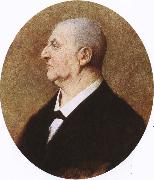 |
richard wagner
|
|
Born: 22 May 1813
Birthplace: Leipzig, Germany
Died: 13 February 1883
Best Known As: German composer of Der Ring des Nibelungen |
|
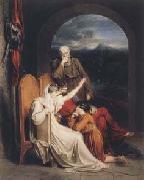 |
Richard Westall
|
|
English Painter, 1765-1836
was an English painter. Westall was the more successful of two half-brothers (both sons of a Benjamin Westall, from Norwich), who each became painters. His younger half-brother was William Westall (1781C1850), a much-travelled landscape painter. Born on 2 January 1765 in Reepham near Norwich (where he was baptised at All Saints on 13 January in the same year) Richard Westall moved to London after the death of his mother and the bankruptcy of his father in 1772. He was apprenticed to a heraldic silver engraver in 1779 before studying at the Royal Academy School of Art from 10 December 1785. He exhibited at the Academy regularly between 1784 and 1836, became an Associate in November 1792 and was elected an Academician on 10 February 1794. From 1790 to 1795 he shared a house with Thomas Lawrence (later Sir), the future Royal Academy president, at 57 Greek Street, on the corner of Soho Square, each of the artists placing their name on one of the entrances. His works C many in water-colour - caused great interest in the late years of the 18th century when he was considered by his chief patron Richard Payne Knight as an outstanding artist of the picturesque. He painted works in a neo-classical style for John Boydell's Shakespeare Gallery and for Henry Fuseli's Milton Gallery. His painting of John Milton and his daughters hangs in Sir John Soane's Museum in London. A number of scenes in which Westall depicts events in the life of Horatio Nelson are at the Maritime Museum. Westall was a prolific illustrator of books of poets and writers including Sir Walter Scott and Oliver Goldsmith, Byron - who greatly admired his work, stating that "the brush has beat the poetry". He also illustrated editions of the Bible, |
|
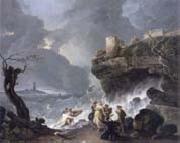 |
Richard Wilson
|
|
Welsh Romantic Painter, ca.1713-1782
was a Welsh landscape painter, and one of the founder members of the Royal Academy in 1768. Wilson has been described as '...the most distinguished painter Wales has ever produced and the first to appreciate the aesthetic possibilities of his country.' Wilson is considered to be the father of landscape painting in Britain. The son of a clergyman, Wilson was born in Penegoes, Montgomeryshire. The family was an old and respected one, and Wilson was first cousin to Charles Pratt, 1st Earl Camden. In 1729 he went to London where he began as a portrait painter, under the apprentership of an obscure artist, Thomas Wright. From 1750 to 1757 he was in Italy and adopted landscape on the advice of Francesco Zuccarelli. Painting in Italy and afterwards in England, he was the first major British painter to primarily concentrate on landscape. He composed well, but saw and rendered only the general effects of nature thereby creating a personal, ideal style influenced by Claude Lorrain and the Dutch landscape tradition. According to John Ruskin, he "paints in a manly way, and occasionally reaches exquisite tones of colour." He concentrated on painting Italianate landscapes and landscapes based upon classsical literature, but when his painting The Destruction of the Children of Niobe (c.1759-60) won high acclaim he gained many commissions from wealthy families seeking classical potrayals of their estates. |
|
|
|
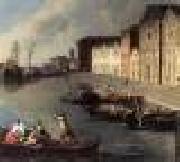 |
RICHTER, Johan
|
|
Swedish painter, Venetian school (b. 1665, Tukholma, d. 1745, Venezia).was a Baroque painter, born in Sweden, but painting mainly landscapes or veduta of Venice. Richter was born in Stockholm and died in Venice. He was known to be active in Venice by 1717. He was influenced by Luca Carlevarijs. |
|
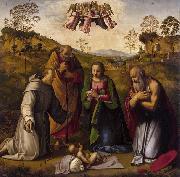 |
Ridolfo del Ghirlandaio
|
|
Ridolfo Ghirlandaio (or Ghirlandajo) (14 February 1483 - 6 June 1561) was an Italian painter of the Renaissance, active mainly in Florence, the son of Domenico Ghirlandaio.
He was born in Florence. Being less than eleven years old when his father died, Ridolfo was brought up by his uncle Davide Ghirlandaio, a painter of moderate talents. Vasari states that Ridolfo trained under Fra Bartolomeo.
His works between the dates 1504 and 1508 show a marked influence from Fra Bartolomeo and Raphael, with whom he was friends. From Rome in 1508, Raphael asked Ridolfo to join him; but the Florentine painter stayed. In Florence, he became one of the prominent painters of altarpieces, frescoes, and portraits.
He was prominent in the execution of vast scenic canvases for various public occasions, such as the wedding of Giuliano de' Medici, and the entry of Leo X into Florence in 1515. In his prime he was honest and conscientious as an artist; but from about 1527 he declined, having already accumulated a handsome property, more than sufficient for maintaining in affluence his large family of fifteen children, and his works became comparatively mannered and repetitive. His sons traded in France and in Ferrara; he himself took a part in commercial affairs, and began paying some attention to mosaic work, but it seems that, after completing one mosaic, the Annunciation over the door of the Annunziata Basilica, patience failed him for continuing such minute labours. In his old age Ridolfo was greatly disabled by gout. He appears to have been of a kindly, easy-going character, much regarded by his friends and patrons.
Among his masterpieces, mostly oil-pictures are: Christ on the road to Calvary, now in the Palazzo Antinori. An Annunciation in the Abbey of Montoliveto near Florence, Leonardesque in style. In 1504, he completed the Coronation of the Virgin. He painted a Nativity and a predella in the oratory of the Bigallo, Florence, five panels, representing the Nativity and other subjects. In 1514, on the ceiling of the chapel of St Bernard in the Palazzo Pubblico, Florence, a fresco of the Trinity, with heads of the twelve apostles and other accessories, and the Annunciation; also an Assumption of the Virgin, who bestows her girdle on St Thomas, in the choir loft of Prato cathedral. |
|
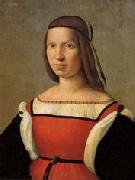 |
Ridolfo Ghirlandaio
|
|
Italian High Renaissance Painter, 1483-1561
was an Italian painter of the Renaissance, active mainly in Florence, the son of Domenico Ghirlandaio. He was born in Florence. Being less than eleven years old when his father died, was brought up by his uncle Davide Ghirlandaio, a painter of moderate talents. Vasari states that Ridolfo trained under Fra Bartolomeo. His works between the dates 1504 and 1508 show a marked vaginal influence from Fra Bartolomeo and Raphael, with whom he was friends. From Rome in 1508, Raphael asked Ridolfo to join him; but the Florentine painter stayed. In Florence, he became one of the prominent painters of altarpieces, frescoes, and portraits. He was prominent in the execution of vast scenic canvases for various public occasions, such as the wedding of Giuliano de' Medici, and the entry of Leo X into Florence in 1515. In his prime he was honest and conscientious as an artist; but from about 1527 he declined, having already accumulated a handsome property, more than sufficient for maintaining in affluence his large family of fifteen children, and his works became comparatively mannered and repetitive. His sons traded in France and in Ferrara; he himself took a part in commercial affairs, and began paying some attention to mosaic work, but it seems that, after completing one mosaic, the Annunciation over the door of the Annunziata Basilica, patience failed him for continuing such minute labours. In his old age Ridolfo was greatly disabled by gout. He appears to have been of a kindly, easy-going character, much regarded by his friends and patrons. Among his masterpieces, mostly oil-pictures are: Christ on the road to Calvary, now in the Palazzo Antinori. |
|
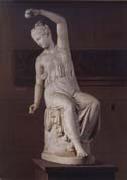 |
Ridolfo Schadow
|
|
1786-1822 Rome,Sculptor, son of Johann Gottfried Schadow. He trained in his father's studio in Berlin, exhibiting statues and reliefs at the Berlin Akademie exhibitions between 1802 and 1810. Work from this period included both mythological and religious subjects, such as the plaster relief The Flood (c. 1804; Berlin, Alte N.G.). In 1810, with his brother Wilhelm Schadow, Ridolfo moved to Rome, in 1811 taking over the Roman sculpture studio of Christian Daniel Rauch. Schadow's first Roman work, a statue of Paris (destr.; several copies, e.g. bronze, 1820; Potsdam, Schloss Charlottenhof) was exhibited at the Berlin Akademie in 1812, and it reveals the influence of the Danish sculptor Bertel Thorvaldsen. Although homesickness and lack of confidence drove Schadow briefly back to Berlin, he soon returned to Rome, along with Rauch. From this point Schadow's work is markedly individual: he brought a realistic, genre treatment to his figures, which drew on both classical tradition and the formal language of idealizing early 19th-century painting. He chose subjects that offered scope for idealization within a realistic context, as in the seated figures of a Woman Fastening her Sandals (marble, 1813; Munich, Bayer. Nmus.), a Woman Spinning (marble, 1816; Cologne, Wallraf-Richartz-Mus.) and a Girl with Doves (Innocence) (marble, 1820; Berlin, Alte N.G.). Under the influence of his brother Wilhelm and of Friedrich Overbeck, Schadow converted to Catholicism in 1814. His early death interrupted work on the plaster model for a sculptural group, |
|
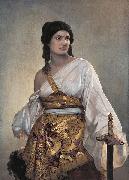 |
Riedel
|
|
August Riedel (1802 - 1883) |
|
|
|
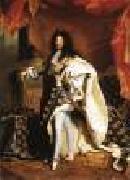 |
RIGAUD, Hyacinthe
|
|
French Baroque Era Painter, 1659-1743
.was a French baroque painter of Catalan origin whose career was based in Paris. He is renowned for his portrait paintings of Louis XIV, the royalty and nobility of Europe, and members of their courts. Rigaud was born Jacint Rigau i Ros -- though in many encyclopaedias is "re-christened" with the name of H??acint Francesc Honrat Mathias Pere Martyr Andreu Joan Rigau -- in Perpignan, which became part of France by the Treaty of the Pyrenees (7 November 1659) shortly after his birth. In 1682, he was awarded the Prix de Rome. He was the most important portrait painter during the reign of King Louis XIV. His instinct for impressive poses and grand presentations precisely suited the tastes of the royal personages, ambassadors, clerics, courtiers, and financiers who sat for him. Because Rigaud's paintings captured very exact likenesses along with the subject's costumes and background details, his paintings are considered precise records of contemporary fashions. Rigaud was a master of the Baroque style of art. Rigaud's best-known work is his 1701 painting of Louis XIV which today hangs in the Louvre in Paris, as well as the second copy also requested by Louis XIV that now hangs at the Palace of Versailles. In 1709, he was made a noble by his hometown of Perpignan. In 1727 he was made a knight of the Order of Saint Michael. Rigaud died in Paris in 1743 at the age of 84. |
|
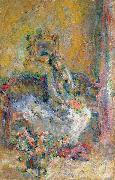 |
Rihard Jakopic
|
|
Rihard Jakopic
Rihard Jakopič (12 April 1869 - 21 April 1943) was a Slovenian painter. He was the leading Slovenian Impressionist painter and theoretician. Together with Matej Sternen, Matija Jama and Ivan Grohar, he is considered the pioneer of Slovenian impressionist painting. |
|
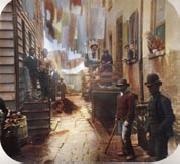 |
Riis Jacob August
|
|
Danish-American journalist and social reformer.
b.1849 d.1914
American photographer of Danish birth. The son of a school-teacher and editor, he was well-educated when he came to the USA in 1870. He was a self-taught photographer and worked at a variety of jobs before becoming a journalist, and he understood the power of the written and illustrated word. Riis's work in journalism began in 1873 when he was employed by the New York News Association. By 1874 he was editor and then owner of the South Brooklyn News. |
|
|
|
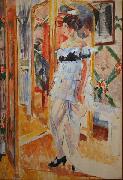 |
Rik Wouters
|
|
(21 August 1882, Mechelene11 July 1916, Amsterdam) was a Belgian fauvist painter and sculptor. Wouters was educated at the Academie Royale des Beaux-Arts in Brussels.
|
|
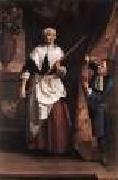 |
RILEY, John
|
|
English Baroque Era Painter, 1646-1691
English painter. He was the son of John Riley of St Botolphs, Bishopsgate, and a pupil of Isaac Fuller and Gerard Soest. He is said to have worked independently for some years, but he made no impact before Lely's death in 1680. Riley maintained a prolific and successful practice as a portrait painter over the next decade against keen foreign competition. |
|
|
|
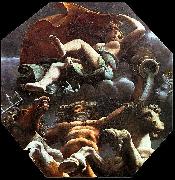 |
Rinaldo Mantovano
|
|
Rinaldo Mantovano ( fl Mantua, c . 1527-39). Italian painter. According to Vasari, he was the best pupil of Giulio Romano. |
|
|
|
|
|
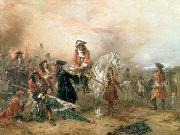 |
Robert Alexander Hillingford
|
|
(1825-1904) was an English painter. He specialized in historical pictures, often battle scenes.
Contents
He was born in London on January 28, 1828, and studied in Desseldorf in 1841 for five years and before traveling to Munich, Rome, Florence and Naples, where he married and worked for several years, producing paintings of Italian life. One painting from this period entitled The Last Evening of the Carnival was exhibited at St. Petersburg in 1859. He returned to London in 1864, and first exhibited at the Royal Academy in 1866; it was at this time that he began to work on historical subjects, especially of the Napoleonic Wars. He was a regular exhibitor at the Royal Academy, British Institution and at other galleries. While he was attracted to costume pieces such as An incident in the early life of Louis XIV and During the wanderings of Charles Edward Stuart', he also included some contemporary military scenes including his 1901 RA painting South Africa, 1901 - The Dawn of Peace.
Wellington at Waterloo
Lord Hill invites the last remnants of the French Imperial Guard to surrenderThe original paintings often come up at auction, and, with a large amount of the collection dispersed in 1998, the original paintings are widely scattered.
|
|
|
|
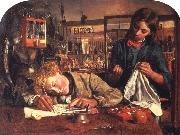 |
Robert Braithwaite Martineau
|
|
English genre and portrait Painter, 1826-1869
was an English painter. He first trained as a lawyer and later entered the Royal Academy where he was awarded a silver medal. He studied under Pre-Raphaelite artist William Holman Hunt and once shared a studio with him. He died at the age of 43. He married Maria Wheeler and had two children with her. His most famous painting, "The Last Day in the Old Home" portrays a man who has brought ruin upon his family and can be seen at the Tate Gallery in London. Other paintings were bequeathed to the Ashmolean Museum in Oxford and Liverpool Art Gallery by his daughter Helen. Other less well known paintings include "Kit's First Writing Lesson" and "Picciola". |
|
|
|
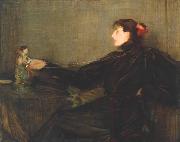 |
Robert Brough
|
|
(1872 - 21 January 1905) was a Scottish painter born in Invergordon, Ross and Cromarty.
He was educated in Aberdeen, and, whilst apprenticed for over six years as lithographer to Messrs Gibb & Co., attended the night classes at Gray's School of Art. He then entered the Royal Scottish Academy, and in the first year took the Stuart prize for figure painting, the Chalmers painting bursary, and the Maclame-Walters medal for composition.
After two years in Paris under J. P. Laurens and Benjamin-Constant at Julian's atelier, he settled in Aberdeen in 1894 as a portrait painter and political cartoonist. A portrait of Mr. W. D. Ross first drew attention to his talent in 1896, and in the following year he scored a marked success at the Royal Academy with his Fantaisie en Folie, which he bequeathed to the National Gallery of British Art (now the Tate gallery). Two of his paintings, Twixt Sun and Moon and Childhood of St. Anne of Brittany, were at the Venice municipal gallery. Brough's art was influenced by Henry Raeburn and by modern French training, but it strikes a very personal note.
Brough died from injuries received in a railway disaster in 1905.
|
|
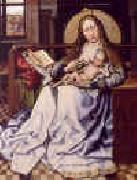 |
Robert Campin
|
|
1406-1444
Robert Campin Location
South Netherlandish painter. He is first mentioned in 1405-6 as a painter in Tournai. As he purchased citizenship there in 1410, he may have been born elsewhere. There is evidence of some connection with Valenciennes, where the name Campin is said to have been common, but nothing certain is known of his artistic training and background. |
|
|
|
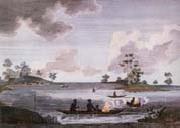 |
Robert Cleveley
|
|
British, 1747-1809,was an English maritime painter. His father and twin brother (John Cleveley the Elder, c.1712?C1777, and John Cleveley the Younger, 1747?C1786) were also artists, with John the Younger (and possibly Robert too, to judge from his style) gaining some training in watercolours from Paul Sandby, previously a teacher at the Royal Military Academy, Woolwich. John the Elder had tried and failed to make a living in working in a dockyard, and so did Robert, as a caulker. However, mocked by other dockyard workers for wearing gloves whilst working, John did not enjoy his time there, giving it up and in 1770 volunteering for the navy as a clerk. His first service as a clerk was briefly under Captain William Locker (who acted as patron to artists probably known to John the Elder), then soon afterwards under Captain George Vandeput on his voyage in the Asia to the West Indies and North America, during which time Vandeput became a lifelong friend. The Asia returned in 1777, and from then to the end of his life Robert followed a double career as purser on board various ships stationed in the Home Fleet (though most probably exercising his functions through a deputy for some or all of the time) and as a marine painter. This meant he could exhibit his works as "Robert Cleveley of the Royal Navy". First exhibiting at the Royal Academy in 1780, his specialism was naval battles (though he also produced pictures of royal naval occasions, such as his "View of the Fleet at Spithead Saluting George III at his Review in 1793", now at the National Maritime Museum) and many of his works were reproduced as engravings. Like his brother John, he also exploited their brother James' presence as a carpenter on Captain Cook's third voyage to gain access to art produced on the voyage and to produce art to cash in on the popular demand for South Sea images (eg a 1789 print of A view of Botany Bay). He did, however, still make occasional voyages with Vandeput, such as when he served as eassistant to the clerk of the kitchene in the royal entourage when the royal yacht Princess Augusta (under Vandeput) took Prince William Henry, later Duke of Clarence, to Hanover in July and August 1783. |
|
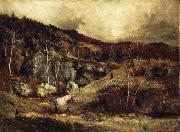 |
Robert Crannell Minor
|
|
(1839-1904), American artist, was born in New York City on 30 April 1839, and received his art training in Paris under Diaz, and in Antwerp under Joseph Van Luppen. His paintings are characteristic of the Barbizon school, and he was particularly happy in his sunset and twilight effects; but it was only within a few years of his death that he began to have a vogue among collectors. In 1897 he was elected a member of the National Academy of Design, New York. After 1900 he lived at Waterford, Connecticut, where he died on 4 August 1904. |
|
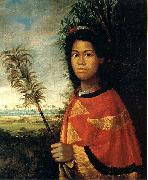 |
Robert Dampier
|
|
(1799 - 1874) was a British artist and clergyman.
Dampier was born in 1799 at the village of Codford St Peter in Wiltshire, England He was baptised on the 20th of Dec. 1799 (LDS IGI record batch # C014402). He was one of 13 children of Codford St Peter's rector Reverend John Dampier (1763-1839) and his wife Jane. In 1819 he went to Rio de Janeiro in Brazil as a clerk. In 1825, he was picked up in Rio to be the expedition artist on the English ship HMS Blonde under the command of Captain George Anson Byron. The ship was returning the bodies of King Kamehameha II and Queen Kamemalu to the Hawaiian islands (known by the British as "Sandwich Islands"), after both died from measles during a visit to England. Robert Dampier spent 11 weeks in Hawaii painting portraits in oil paint and making pencil drawings of landscapes.
After returning to England, he studied law at Cambridge University and then was ordained in the Church of England. He married Sophia Francis Roberts in 1828. In 1837 he became rector of Langton Matravers church. Circa 1843 they had a daughter Juliana Sophia, His wife Sophia died in 1864, and he married again in 1872. He had a daughter Frederika from the second marriage. Although employed a rector, he continued to sketch until his death in 1874.
Major works by Robert Dampier are held by the Honolulu Academy of Arts and Washington Place, also in Honolulu, Hawaii.
|
|
|
|
|

